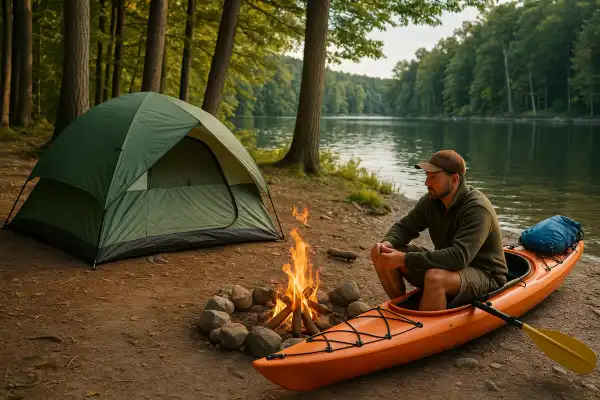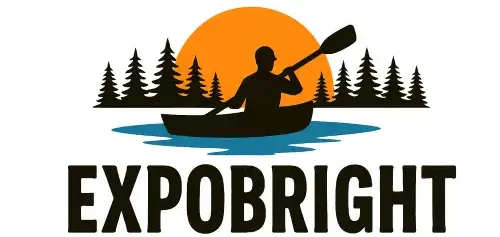Every summer, paddlers across the Midwest find themselves wondering where can you kayak camp in Michigan as they plan their next wilderness escape. Michigan’s abundance of pristine waterways and vast stretches of public land create countless opportunities for those seeking multi-day paddle adventures.
After two decades of exploring Michigan’s waters—from guiding families through the gentle currents of the AuSable to navigating solo expeditions along Lake Superior’s dramatic coastline—I’ve learned that Michigan offers some of the finest kayak camping experiences in North America. The diversity ranges from remote wilderness islands to meandering river corridors lined with designated campsites.
Where can you kayak camp in Michigan?
Michigan offers exceptional kayak camping across both peninsulas, from the pristine wilderness of Isle Royale National Park and the dramatic cliffs of Pictured Rocks National Lakeshore in the Upper Peninsula to the extensive river systems like the AuSable and Manistee in the Lower Peninsula. The state’s national forests—Hiawatha in the UP and Huron-Manistee in the Lower Peninsula—permit dispersed camping almost anywhere, providing endless opportunities for self-reliant paddlers.

Upper Peninsula wilderness destinations
The Upper Peninsula represents Michigan’s crown jewel for wilderness kayak camping. Isle Royale National Park stands as the ultimate destination for experienced kayak campers, offering guided trips through the Keweenaw Adventure Company or independent expeditions for those properly equipped with sea kayaks and wilderness experience. This remote island park requires advance planning, as access is only by ferry, seaplane, or private boat, but rewards visitors with unparalleled solitude and pristine wilderness.
Pictured Rocks National Lakeshore provides spectacular coastal kayak camping along 42 miles of Lake Superior shoreline, though a backcountry permit is required year-round for overnight trips. The lakeshore features designated backcountry campsites accessible only by hiking or kayaking, including sites at Chapel Beach, the Coves, and Mosquito Beach. Paddlers must use sea kayaks and should limit daily distances to 8-12 miles, bringing essential safety equipment including personal flotation devices, bilge pumps, and communication devices.
Hiawatha National Forest encompasses vast areas around the Upper Peninsula, offering dispersed camping opportunities for self-sufficient paddlers. The forest includes numerous inland lakes and river systems where paddlers can establish camps following standard Leave No Trace principles.
Lower Peninsula river systems
The AuSable River system provides Michigan’s most extensive kayak camping network, featuring 102 individually designated primitive campsites spread across a 55-mile stretch from Grayling to Oscoda. Multiple outfitters including Carlisle Canoes and PaddleBrave offer everything from overnight trips to week-long expeditions, providing gear rental and shuttle services for independent paddlers.
The Pine and Manistee Rivers, flowing through the Manistee National Forest, offer some of the Midwest’s finest multi-day paddling experiences. The Manistee River is considered the premier river in the Lower Peninsula for multi-day camping trips, with numerous campgrounds and access sites conveniently spaced along its entire length, accommodating trips ranging from two hours to ten days.
National forest dispersed camping
Both Huron-Manistee National Forests permit dispersed camping almost anywhere within forest boundaries, unless specifically posted otherwise. The key regulation requires maintaining at least 200 feet distance from any river, lake, stream, or water body when establishing dispersed campsites. This rule actually works well for kayak campers, as it encourages proper site selection away from fragile riparian zones.
Specific dispersed camping areas include Green Road within the Nordhouse Dunes Wilderness Area near Lake Michigan, Marzinski Horse Trail Camp, and McKinley Trail Camp in Huron National Forest. These areas provide vault toilets but no water sources, requiring paddlers to carry sufficient water or have reliable purification systems.
Great Lakes coastal camping
Lake Michigan offers developed camping at places like Lake Michigan Campground, situated 15 miles south of Manistee with direct beach access and amenities including flush toilets and shower facilities. Numerous private campgrounds along Michigan’s Great Lakes shoreline provide comfortable base camps for day paddling or overnight stops during longer coastal journeys.
Essential regulations and permits
Pictured Rocks National Lakeshore requires backcountry camping permits year-round, with specific regulations including mandatory food storage in bear-proof containers or suspended at least 10 feet high and 4 feet from trees. Human waste must be disposed of at least 200 feet from trails, campsites, or water sources, buried in holes at least six inches deep.
National forest camping requires no permits for dispersed camping, though developed campgrounds may charge fees and require reservations through Recreation.gov. Firewood collection is permitted within national forests, though purchasing local firewood prevents the spread of invasive species.
Planning considerations
Michigan’s kayak camping season typically runs from May through October, with peak conditions from June through September. Summer weekend crowds can be significant on popular rivers like the AuSable and Manistee, particularly during peak season when outfitters report upwards of 600 people per Saturday on heavily trafficked sections. Planning midweek trips or exploring lesser-known areas provides more solitude.
Weather on the Great Lakes can change rapidly, making proper gear selection crucial. Lake Superior requires sea kayaks and cold-water safety equipment including wet suits or dry suits, even during summer months. River camping generally requires less specialized equipment but still demands waterproof storage for sleeping gear and spare clothing.
Conclusion
Last August, I guided a group of friends on a four-day expedition down the Manistee River, watching their transformation from apprehensive beginners to confident paddlers as we navigated through sections of pristine wilderness. Following proper planning guidelines—from securing permits for backcountry areas to understanding dispersed camping regulations—made the difference between a challenging adventure and a memorable celebration of Michigan’s incredible paddle camping opportunities. Whether pursuing the solitude of Isle Royale’s remote shores or the accessibility of the AuSable’s established campsites, Michigan’s waters offer experiences that create lifelong paddlers and deep connections with the natural world.
